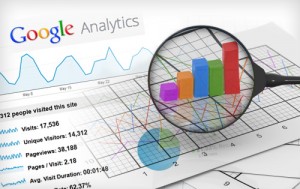By now, even the smallest of small businesses know that an active social media presence is necessary to appeal to web savvy customers in the digital age. But for many, the strategic thinking ends there. The built-in analytics/insights that come with most social platforms really don’t help the problem, since they’re typically not results-oriented enough to drive strategy.

That’s where Google Analytics can help. The versatility and customization available through this great (and free!) set of tools is well worth the effort of learning how to use them. And if you’re already using Google Analytics for your website analytics, it’s a simple step to extend that to social media platforms.
The major flaw in almost all Insights that come bundled within a social media platform is the lack of customization. Think about your Facebook Insights dashboard:

It's very big picture: there’s no way to quantify specific content marketing efforts, to follow clicks through to their end result, or to even adjust the layout of your Insights so they fit the data you’re interested in. Facebook Insights (and Pinterest Analytics, Twitter Analytics, etc.) are only interested in the kind of results you can achieve within the platform, like post views, shares, clicks, likes, retweets, repins, and comments. But you’re running a business, not a social media extravaganza. You need to be able to quantify results beyond all that, to determine what types of content and marketing efforts work best for your bottom line.
1. Track social media visitors using customized URLs.
You’ve probably seen these types of long, complicated URLs before – they often have the name of the post or website included, and then a lot of garbled text and symbols at the end. These are called UTM parameters, and they allow you to send data back to your Google Analytics whenever someone uses that specific link to reach your page, maybe by clicking on a link in your Facebook post or tweet. Create your own trackable URL with Google’s easy to use URL Builder.
Related Class: Introduction to Web Analytics
There are many advantages to keeping track of clicks through UTM parameters rather than through the Insights/Analytics that come with each social channel. Google Analytics will give you one easy place to compare clicks across all your platforms, so you can see which types of content or offers perform best on which of your platforms. This makes it easier to think strategically about content, instead of blanketing all off your social channels with the same posts. You can also use UTM parameters to track things like sponsored posts, advertising campaigns, etc., so it will be clear which ad keywords or images are performing best for you.
2. Set goals to get results-driven data.
When Facebook Insights or Twitter Analytics shows me that several people clicked on a link to a landing page that I posted/tweeted, I’m glad to hear it. But it’s not exactly data you can take back to the CEO or sales team to show your success in social media. Using Google Analytics to set goals will help you keep track of the behavior of social media users once they get onto your site, and can give you much more detailed, actionable data than you’ll get from social media insights alone.
Related Class: How to Measure Social ROI
Since you create your own goals in Google Analytics, you’ll be able to identify exactly the behaviors you’re interested in. For example, if I wanted to test the success of a blog post, I could set a duration goal to monitor when visitors stay on the page for over 45 seconds or 1 minute. Or if the blog post drives readers with a CTA like downloading an eBook or reading more on another page, I can set a destination goal for when they click on the link and land on that specific page. If your interest is in specific actions (signing up for the mailing list, downloading a product guide, playing a video) you can create event goals associated with those actions.

If you’re already using Google Analytics, I don’t need to tell you that there are many, many more ways to use this free service to track your efforts and refine your strategy. From A/B testing ad buys to focusing the content you share, these tools are more specific, customizable and ultimately useful than the built-in insights you get from Facebook and other platforms. Use both together to get a big picture and close up look at your social media efforts and their results.
